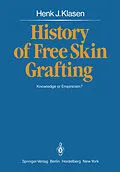1. Experiences With and Views on Skin Grafting Prior to Reverdin's Invention (1869).- 2. Skin Grafting by the Reverdin Method and Subsequent Developments.- A. The Skin Grafts of Jaques-Louis Reverdin.- Reverdin's Technique of Skin Grafting.- Indications for a Reverdin Skin Graft.- General Indications.- Looking for Indications in Reconstructive Surgery.- Criteria Applied to the Wound.- Skin Grafting Technique.- Preparation of the Wound.- Technique of Obtaining Grafts.- Nature of the Grafts.- Dimensions and Thickness of the Grafts.- Application of the Grafts.- Dressing After Grafting.- The First Wound Inspection.- Consequences of Grafting.- The Reaction of the Wound.- The Reaction of the Grafts.- Wound Healing After Skin Grafting.- Results of Skin Grafting.- B. The Grafting of Epithelium Without Corium.- Epithelial Scrapings.- Warts.- Hair Roots.- C. Homografting.- Sources of Skin for Homografting.- Survival Chances of Homografts.- Complications in Homografting.- Unexplained Failures After Homografting.- D. Heterografting.- References.- 3. Skin Grafting in Eyelid Surgery.- A. Lawson's Successful Reconstruction.- B. Other Initiatives in Eyelid Grafting.- C. Wolfe and the Full-Thickness Skin Graft.- D. Further Application of the Full-Thickness Skin Graft.- E. The Split-Skin Graft in Eyelid Surgery.- F. Dressing Technique.- G. Results.- H. Skin Grafting in Other Eyelid Abnormalities.- I. Skin Grafting on Fresh Eyelid Wounds.- References.- 4. Application of the Principles of Thiersch in Skin Grafting, and Further Developments (1886-1900).- A. Skin Grafting According to the Principles of Carl Thiersch.- The Thiersch Principles Elaborated by his Pupils.- Indications for Skin Grafting in Thiersch's Surgical Department.- Preparation of the Wound.- Selection of the Donor Site.- Taking Grafts, Their Thickness and Dimensions.- Application of the Grafts.- Complications.- Application of the Thiersch Principles Outside Leipzig.- Indications for Skin Grafting.- Preparatory Measures.- Thickness and Dimensions of the Grafts.- Application of the Grafts.- Wound Dressing After Grafting.- Postoperative Treatment and Results of Skin Grafting.- Results of Skin Grafting in Ulcers of the Leg.- Healing After Split-Skin Grafting.- Changes in the Wound Bed.- Changes in the Graft.- Preservation of Skin Grafts.- B. Grafting Epithelial Scrapings.- C. The Full-Thickness Skin Graft.- Indications.- Preparations.- Selection of the Donor Site.- Preparation of the Field of Operation.- Technique of Obtaining Grafts.- Application of the Grafts.- Dressing Technique and Postoperative Treatment.- Grafting Hairy Skin.- Healing of Full-Thickness Skin Grafts.- Epidermal Changes.- Ectodermal Structures.- Corium.- Blood Vessels.- Reactions Between Graft and Wound Bed.- Conclusion.- D. The Use of Homografts and Heterografts After Thiersch's Address (1886).- Homografting.- Heterografting.- References.- 5. Skin Grafting During the First Three Decades of the 20th Century.- A. The Split-Skin Graft.- Indications.- Grafting Technique.- Anaesthesia.- The Donor Site.- Preparation of the Grafted Area.- Development of Technical Aids and Graft-Cutting Technique.- Application of the Graft.- After-Care of the Grafted Area.- After-Care of the Donor Site.- Further Investigations into Healing.- B. The Full-Thickness Skin Graft.- Indications.- Grafting Technique.- The Donor Site.- Graft-Cutting Technique.- Application of the Graft.- Variants of the Full-Thickness Skin Graft.- After-Care.- Results.- Grafting Hairy Skin.- Healing of the Full-Thickness Skin Graft.- C. New Ways in Grafting, or the Way Back?.- Indications for Small Deep Grafts.- Grafting Technique.- Preparation of the Grafted Area.- The Donor Site.- Anaesthesia.- Graft-Cutting Technique.- Application of the Grafts.- After-Care.- Results.- The Combination Technique.- D. Homografting.- Processing of Homografts.- Other Efforts to Ensure Permanent Healing of Homografts.- Homografting Tissues Other Than Skin.- Views on Failures of Homografting.- Study of the Histological Processes in Homografting.- References.- 6. Skin Grafting During the Period 1930-1950.- A. Split-Skin Grafts.- Indications.- Grafting Technique.- General Measures Prior to Skin Grafting.- Preparation of the Grafted Area.- Anaesthesia.- Instruments.- Selection of Donor Sites.- Healing of Donor Sites.- After-Care of Donor Sites.- Preservation of Skin Grafts.- Application of the Grafts.- After-Care of the Grafted Area.- Results of Skin Grafting.- Restoration of Sensibility.- Restoration of the Function of the Sweat Glands.- Restoration of the Function of the Sebaceous Glands.- Changes in Pigmentation.- Healing of Grafts.- B. Full-Thickness Skin Grafts.- Indications.- Grafting Technique.- The Donor Site.- Graft-Cutting Technique.- Application of Grafts and After-Care.- Results.- C. Homografting.- Successful Homografting in Monozygotic Twins.- New Applications.- Research into Failure of Homografting.- Histological Findings.- References.- Summary and Conclusion.- Free Skin Grafting Today and Tomorrow.
